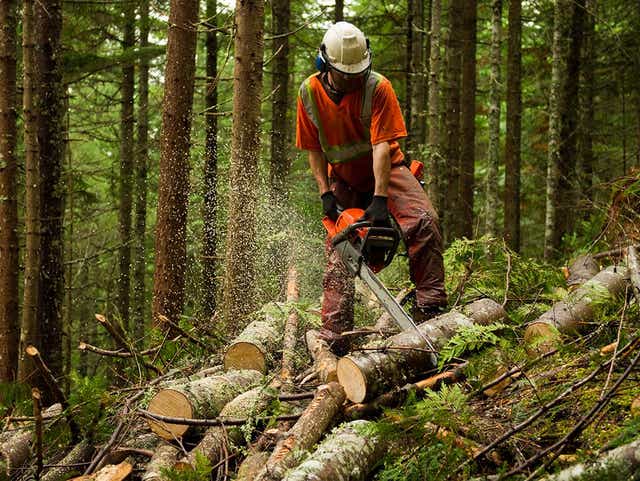Are you interested in working a job that allows you to get your hands dirty and spend time outside?
If so, you should consider a career as a logging worker. Logging workers (informally known as lumberjacks) cut down trees using handheld power chains and mobile felling machines.
But, there’s a lot more to logging than just cutting down trees.
Check out this career guide to learn everything you need to know about working as a logger.
Table of Contents
What Does a Logging Worker Do?
So, what exactly does a logging worker do?
Loggers cut down trees and harvest thousands of acres of forest every year. The timber they cut down provides the raw material for products such as desks, paper, musical instruments, and so much more.
In addition to cutting down trees, logging workers are typically responsible for chopping and cutting wood into smaller pieces so that it can be transported. They may be responsible for hoisting logs onto trucks that are then transported to paper mills, factories, and lumberyards.
Logging workers are also responsible for giving a quality grade score to each piece of log. For this reason, they need to be familiar with the different species of trees.
Here are some other general job responsibilities of a logger:
- €Fastening cables to logs so they can be dragged by tractors
- €Separating logs by species and wood type before loading them onto trucks
- €Operating machinery that transports logs to the landing area
- €Inspecting equipment for safety
- €Performing basic maintenance tasks before using equipment
- €Driving and maneuvering tree harvesters
- €Grading logs according to characteristics such as straightness and knot size
As you can see, loggers are responsible for a lot more than just cutting down trees.
Types of Loggers
It’s also important to understand that there are different types of logging roles. Here are the different roles that make up a logging crew:
Fallers
This is the person who is responsible for cutting down trees using hand-held devices or felling machines.
Buckers
Buckers work alongside fallers. Buckers are responsible for cutting down the tops and trees and branches to specified lengths with the use of a gas-powered chainsaw.
Tree Climbers
Tree climbers use special equipment to scale trees and remove their limbs. When climbing the trees, they need to carry safety gear and heavy tools. To stay safe when climbing, they attach themselves to a rope and harness.
Choke Setters
Choke setters are responsible for fastening steel chains and cables (also known as chokers) around logs that are going to be dragged by tractors.
Log Graders
Log graders, also known as scalers, are responsible for inspecting logs for defects. They’re also responsible for measuring logs in order to find their volume and then estimate their value.
In this role, workers use handheld data collection devices to enter key information about each log.
Log Markers/Movers/Chippers/Sorters
In this role, loggers are responsible for marking, sorting, and moving logs. Logs are sorted and marked based on their size, species, and ownership.
Log markers are also responsible for tending to machines that chip up logs.
Rigging Slingers/Chasers
These loggers are responsible for dismantling wires and cables that are a part of the yarding system.
As you can see, loggers take on many different roles. In a typical logging crew, you’ll find:
1-2 tree fallers
1 bucker
2 choke setters
1 logging equipment operator
Of course, the crew you work with will be part of a much larger logging organization.
What’s the Work Environment Like?
Obviously, loggers work in the forest. While you do get to spend your time outdoors as a logger, it’s important to understand that logging work goes on rain or shine. Sometimes you’ll need to work in isolated areas with poor weather.
It’s also important to understand that logging is a physically demanding and sometimes dangerous job. In fact, logging is the most dangerous job in the world. It’s actually 31 times more dangerous than the average job in America.
Logging workers experience 109.3 fatal injuries per 100,000 workers. Compare this to an oil rigger (the 19th most dangerous job in the nation) where the fatal injury rate is 24.4 deaths per 100,000 workers.
This is why if you work as a logger, it’s so important to work for a company that has hired a reputable logging insurance company.
To get to the logging site, loggers sometimes need to commute long distances. However, if you live in a densely populated area, you can expect your commute to be much shorter.
How Do You Become a Logger?
To become a logger, you’ll need to at least have a high school diploma or GED. Typically, loggers receive on-the-job training where they learn about forest environments and how to operate heavy machinery.
To boost your career, you may want to consider earning an associate’s degree or certificate in forest technology. While not necessary, this can widen your job prospects and give you a leg up on the competition should you ever apply for a managerial position.
Some states even have training programs for loggers, with specific coursework varying by state. These programs typically involve technical instruction, field training, and safety training.
If you choose to become a logging equipment operator, you’ll likely need to undergo additional training through your state forestry department or local logging association. This is because this position requires more technical skills than other logging positions.
Are You Ready to Become a Logging Worker?
Now that you know what it’s like to be a logging worker, it’s time to decide if this is the right position for you. If you decide that logging is right for you, then you should start looking into the specific education and training requirements in your state.
And, be sure to check back in with our blog for more career guides.





